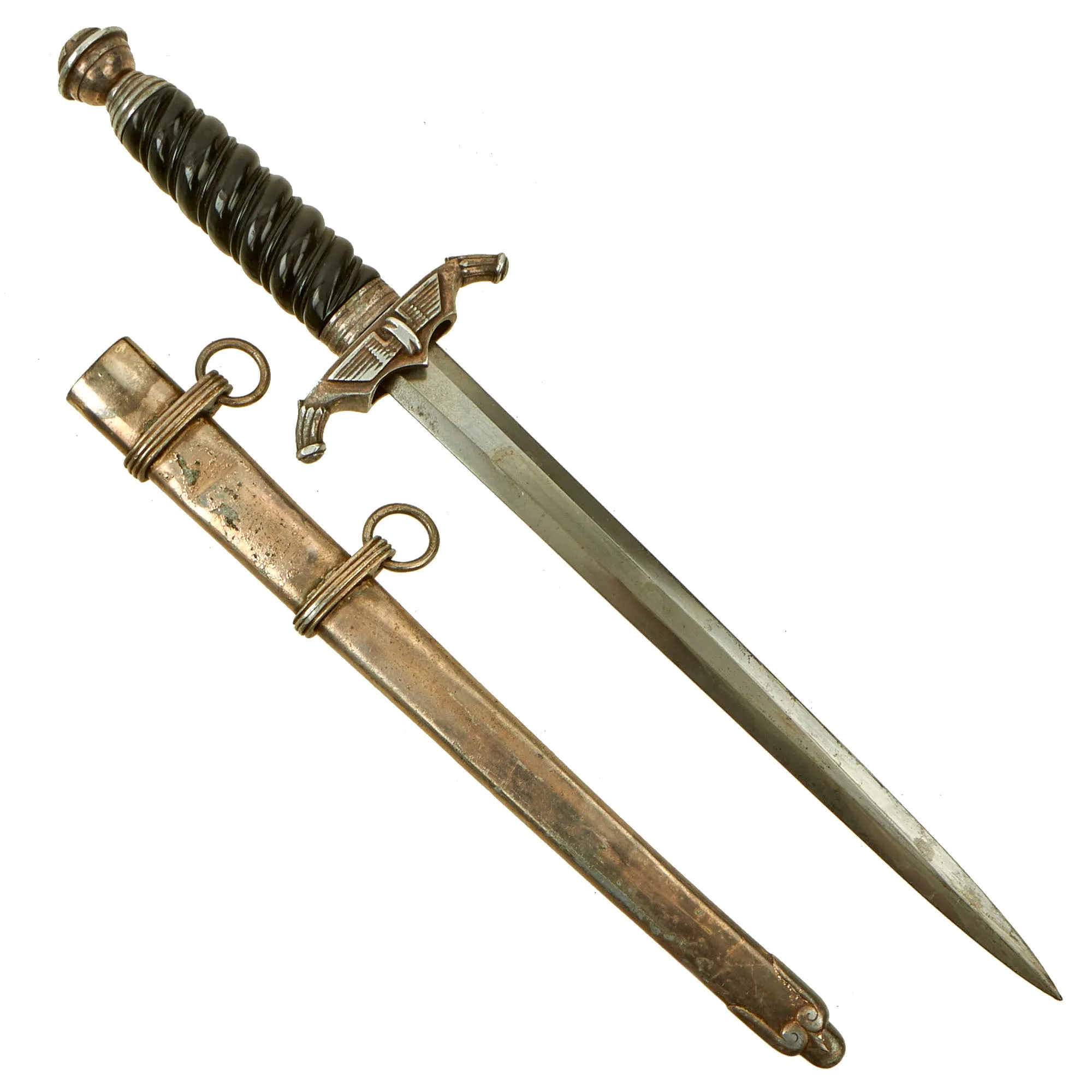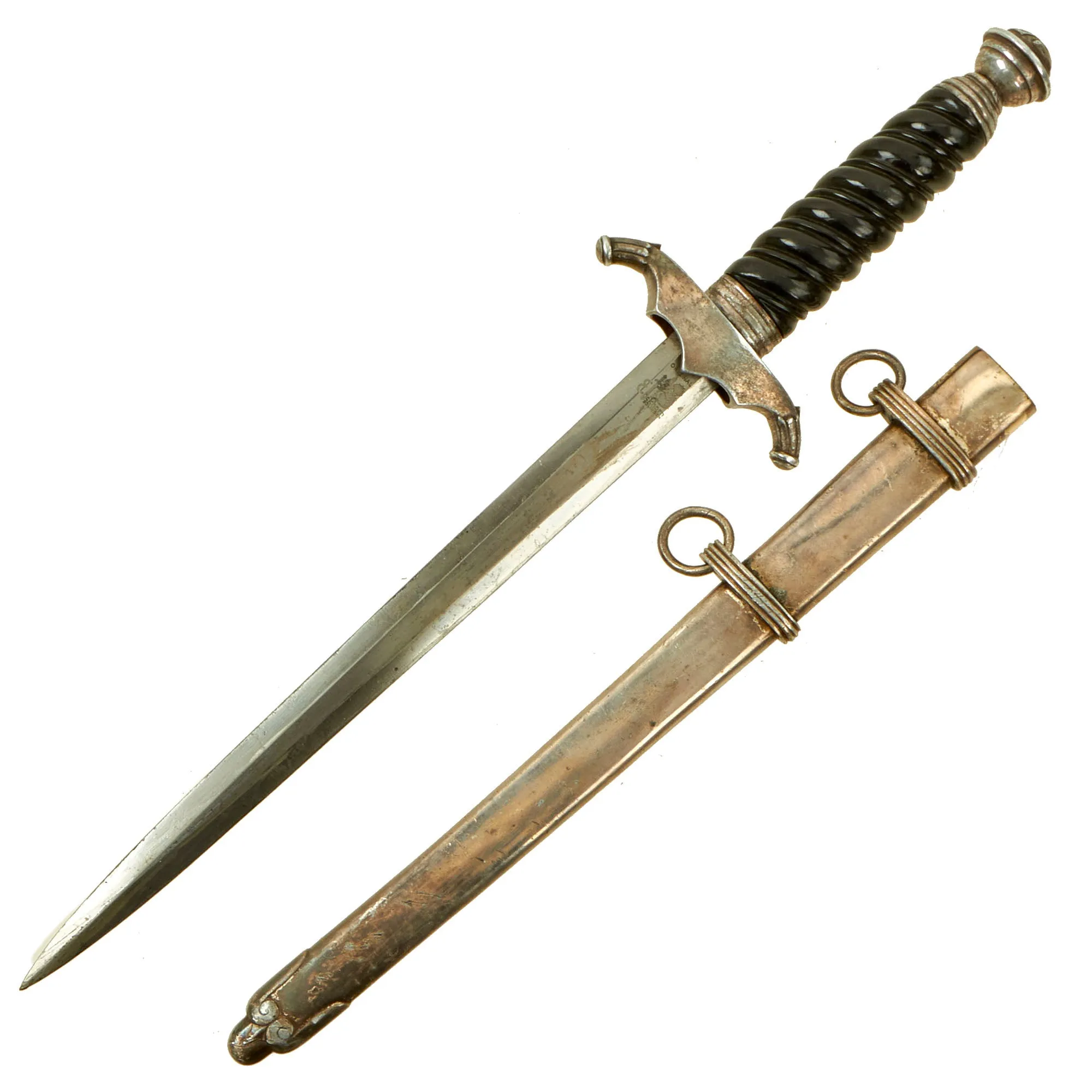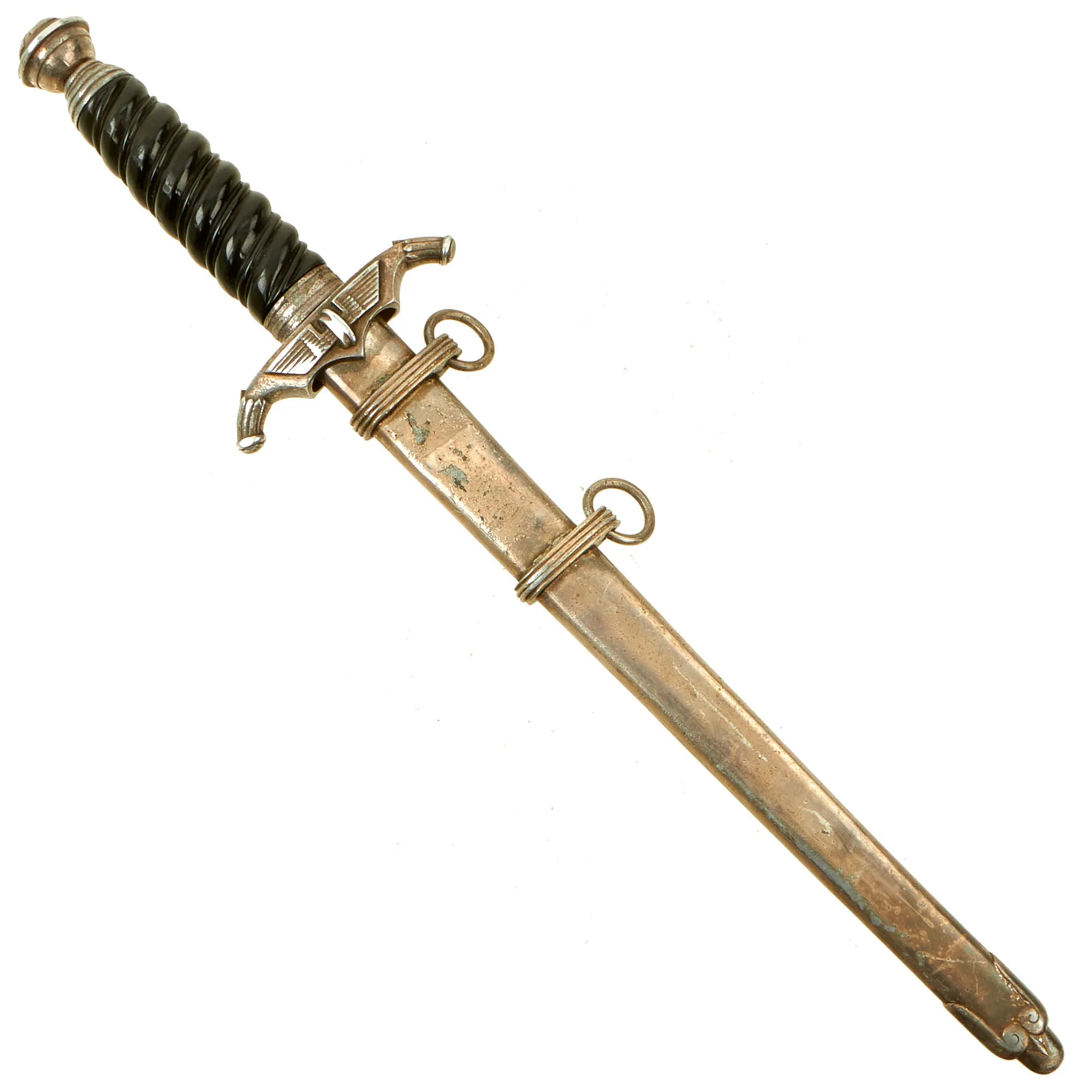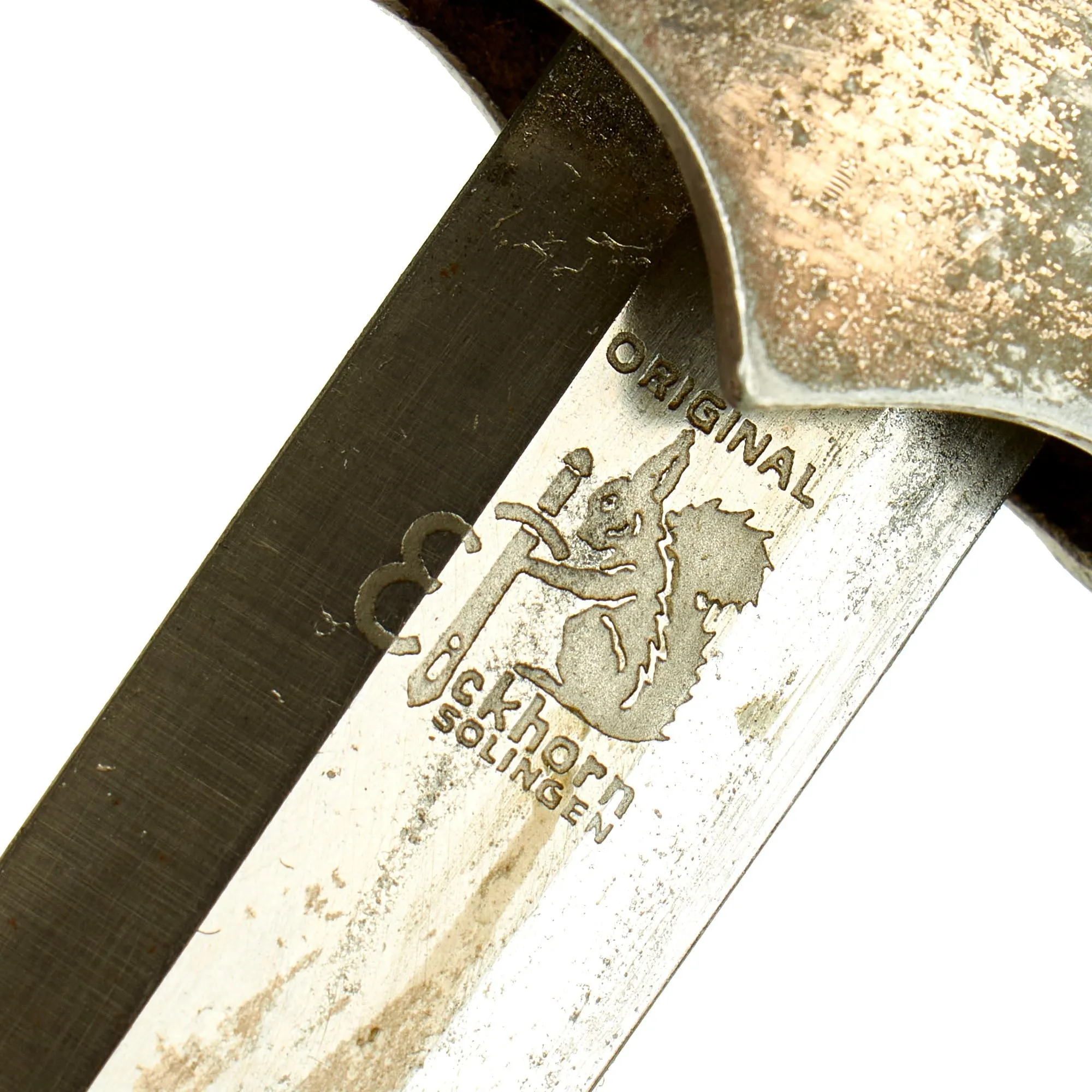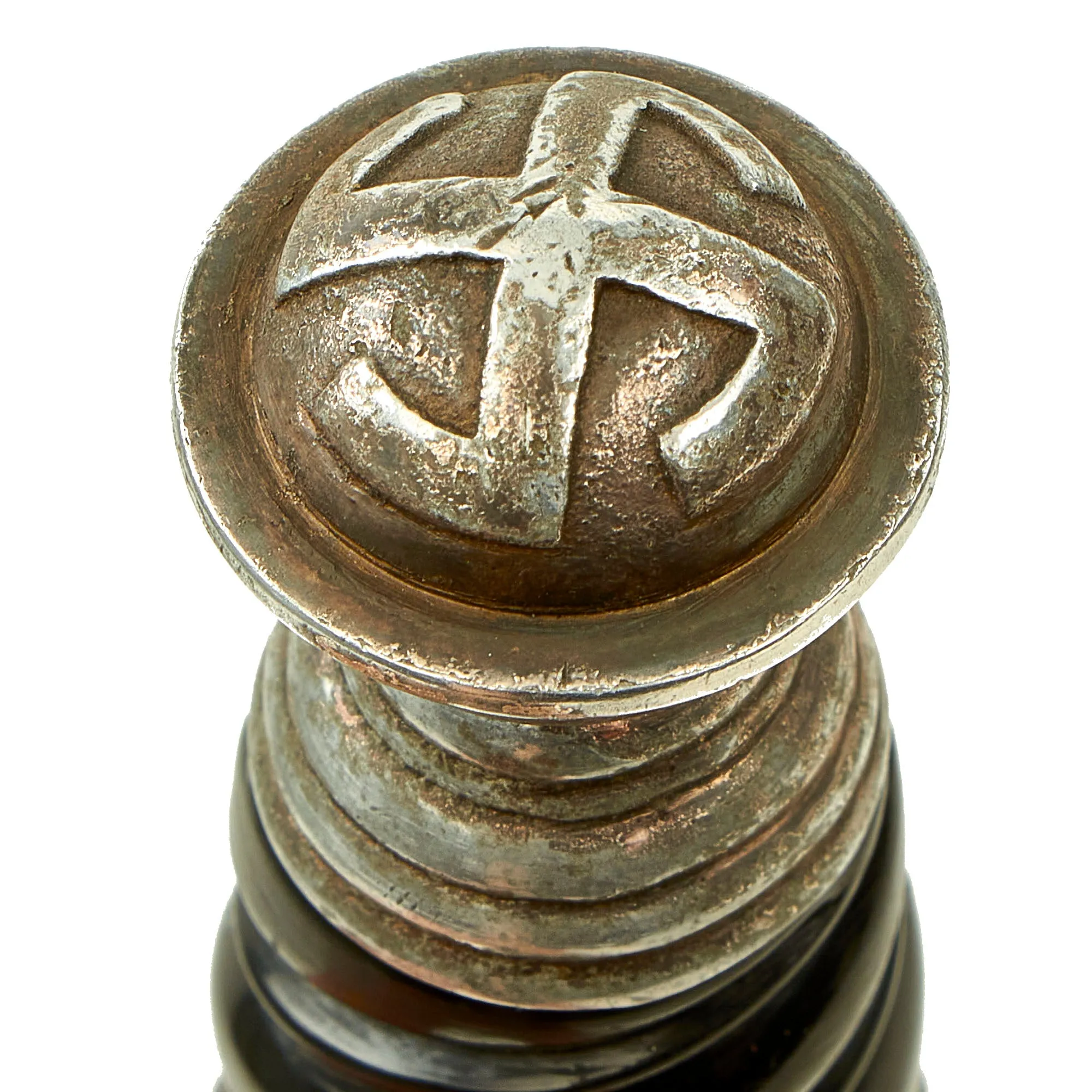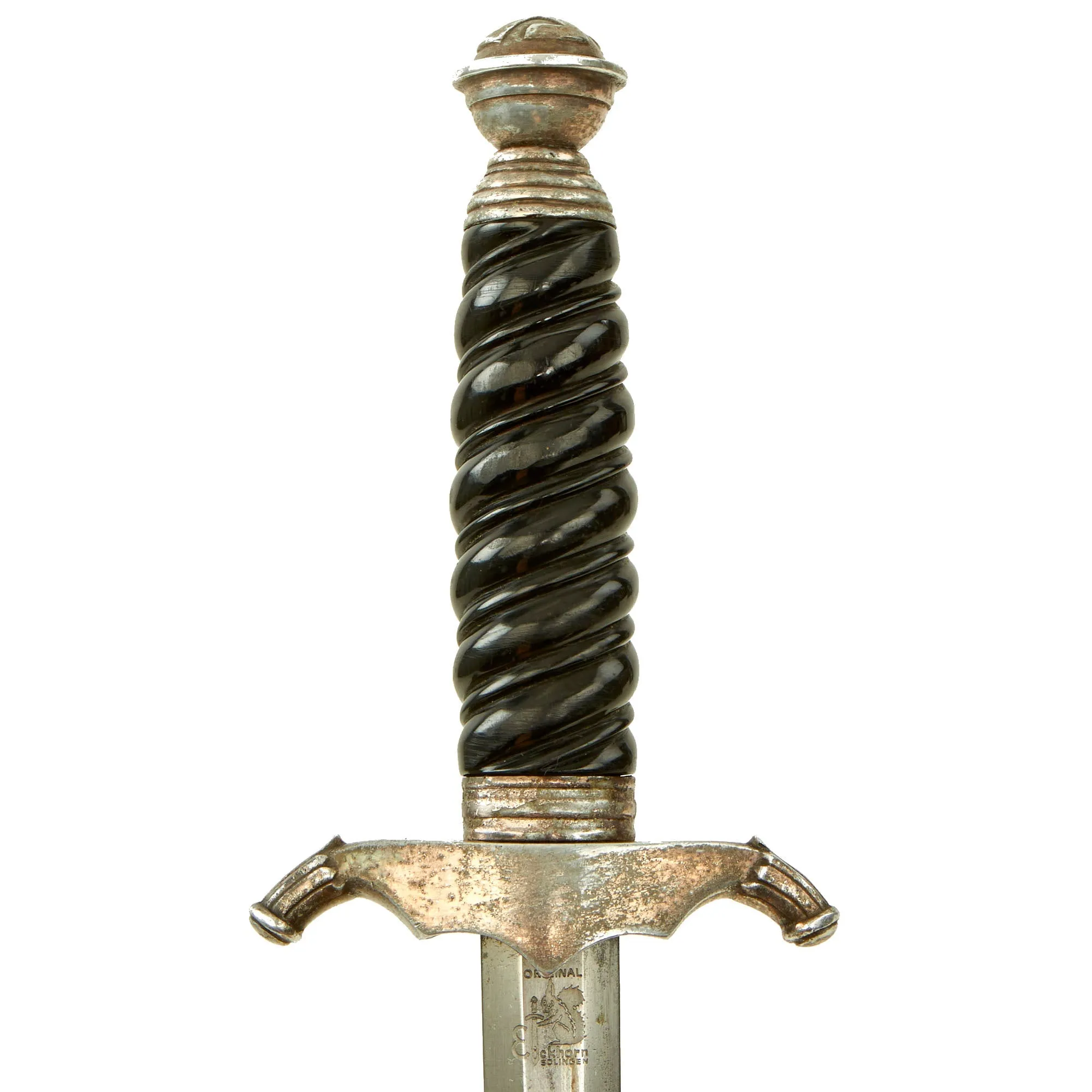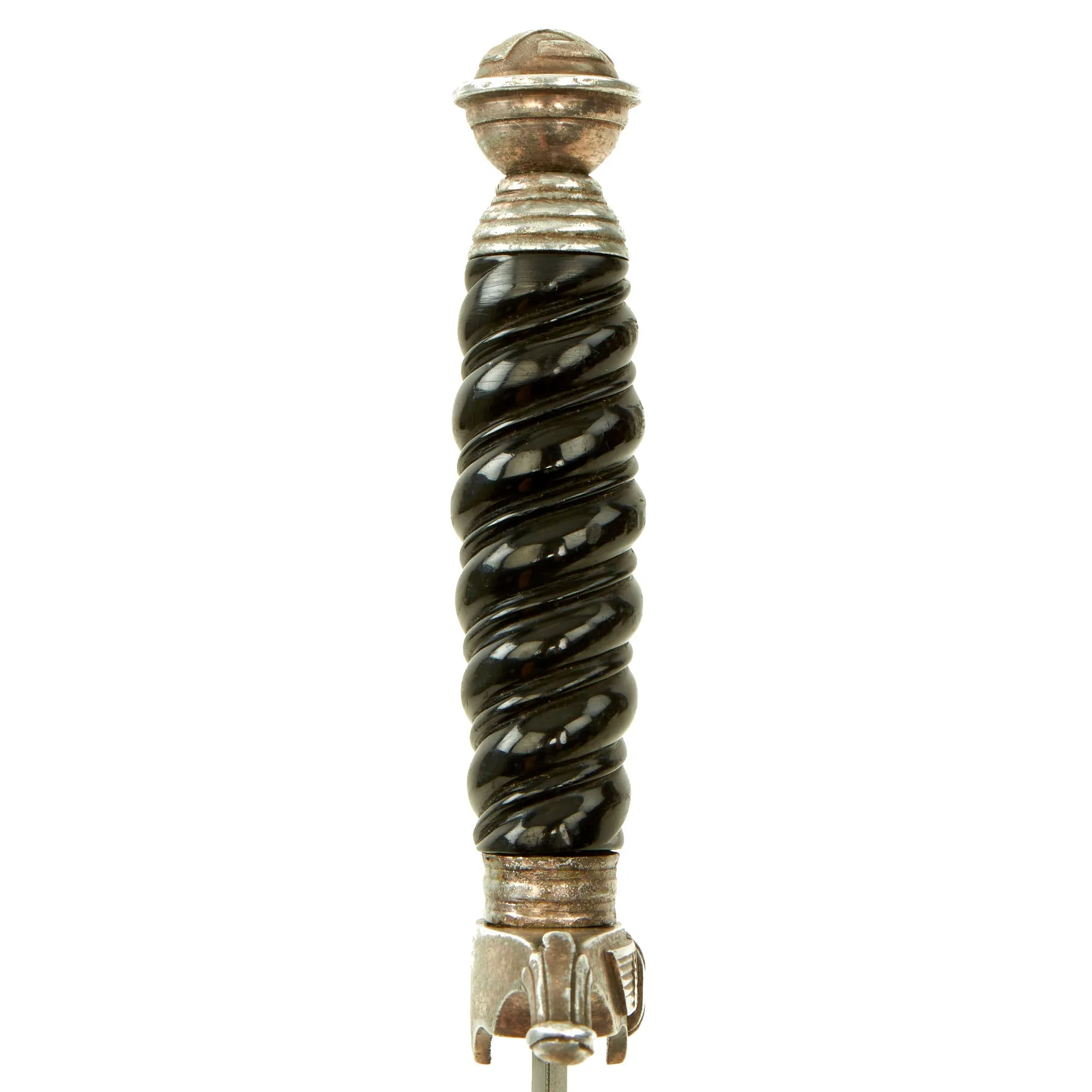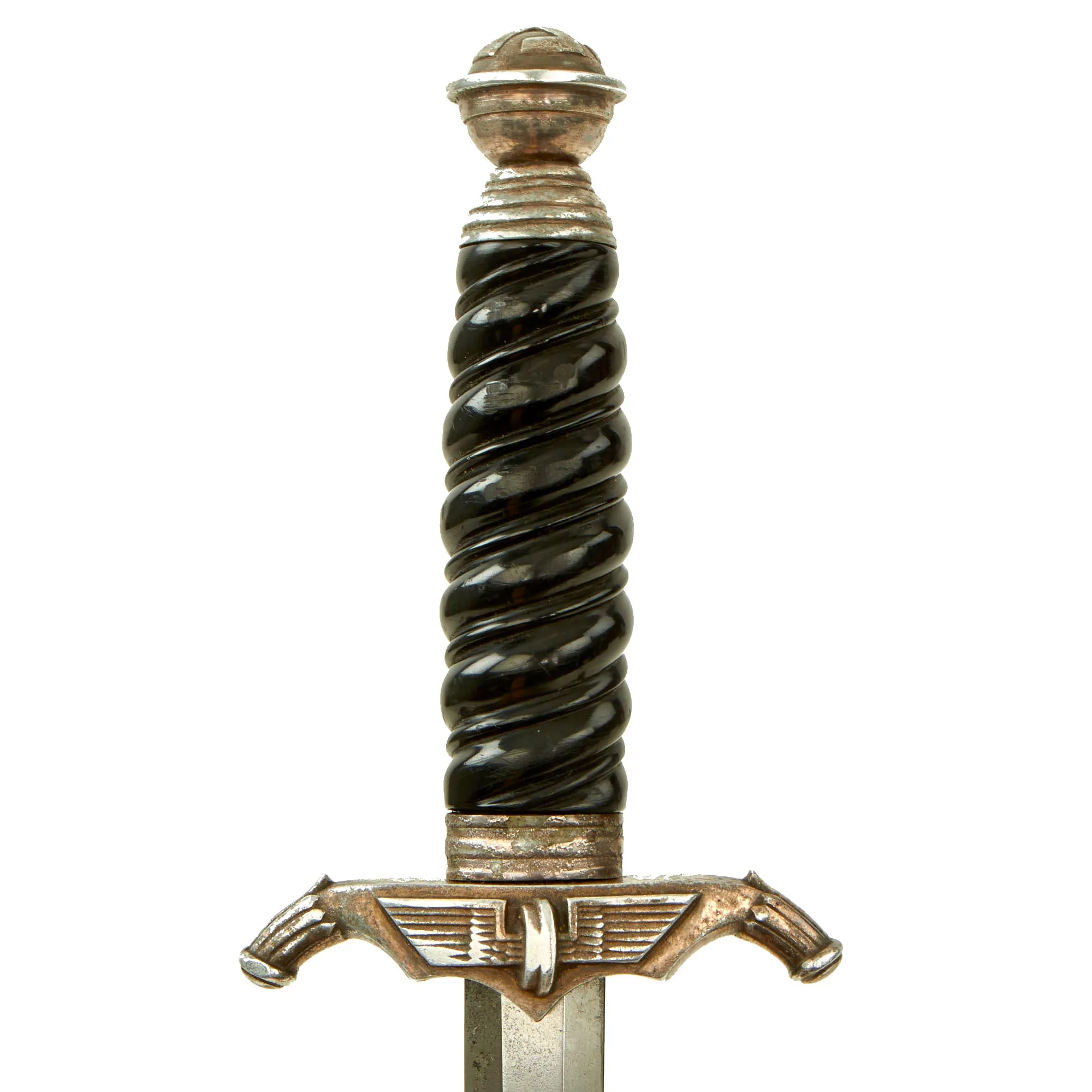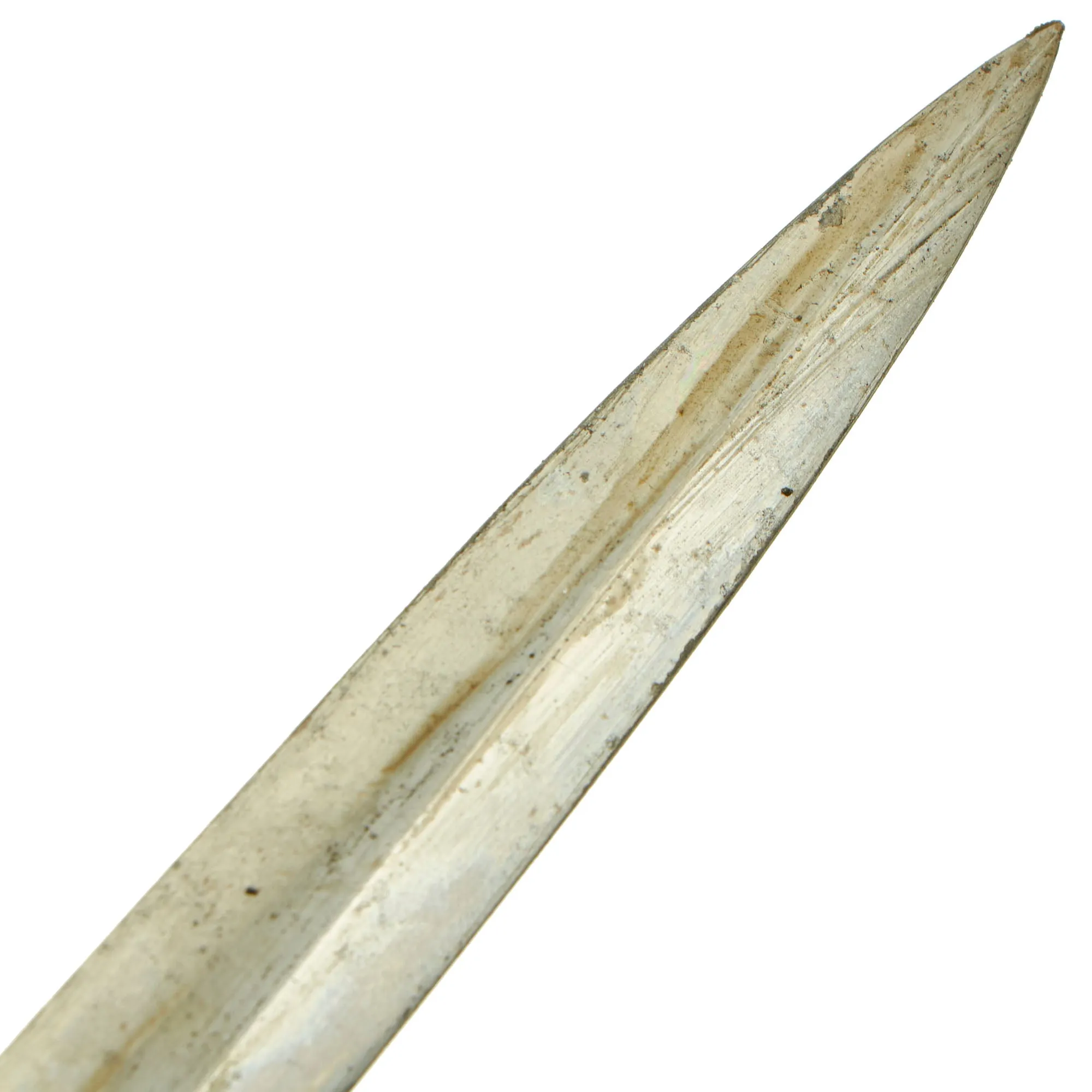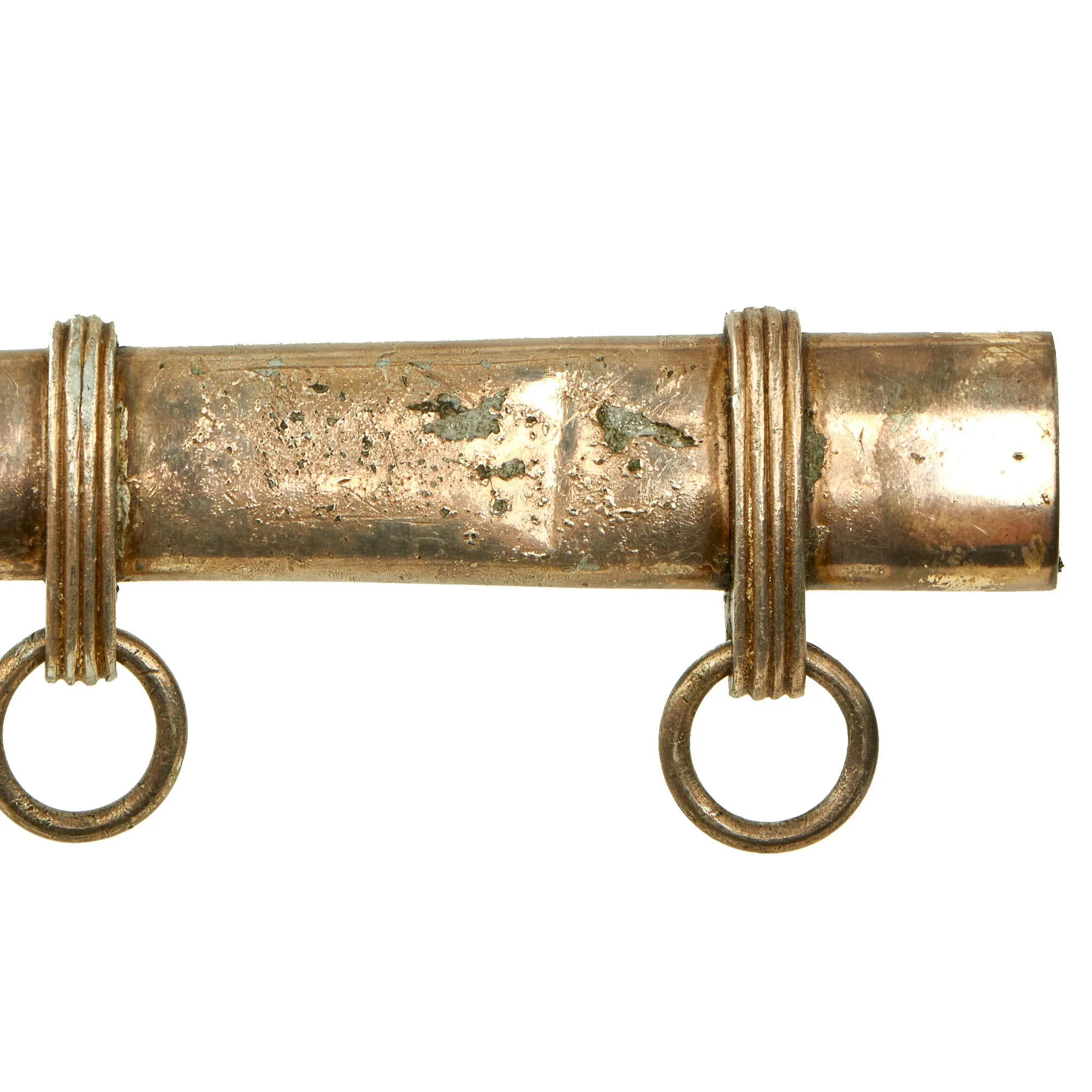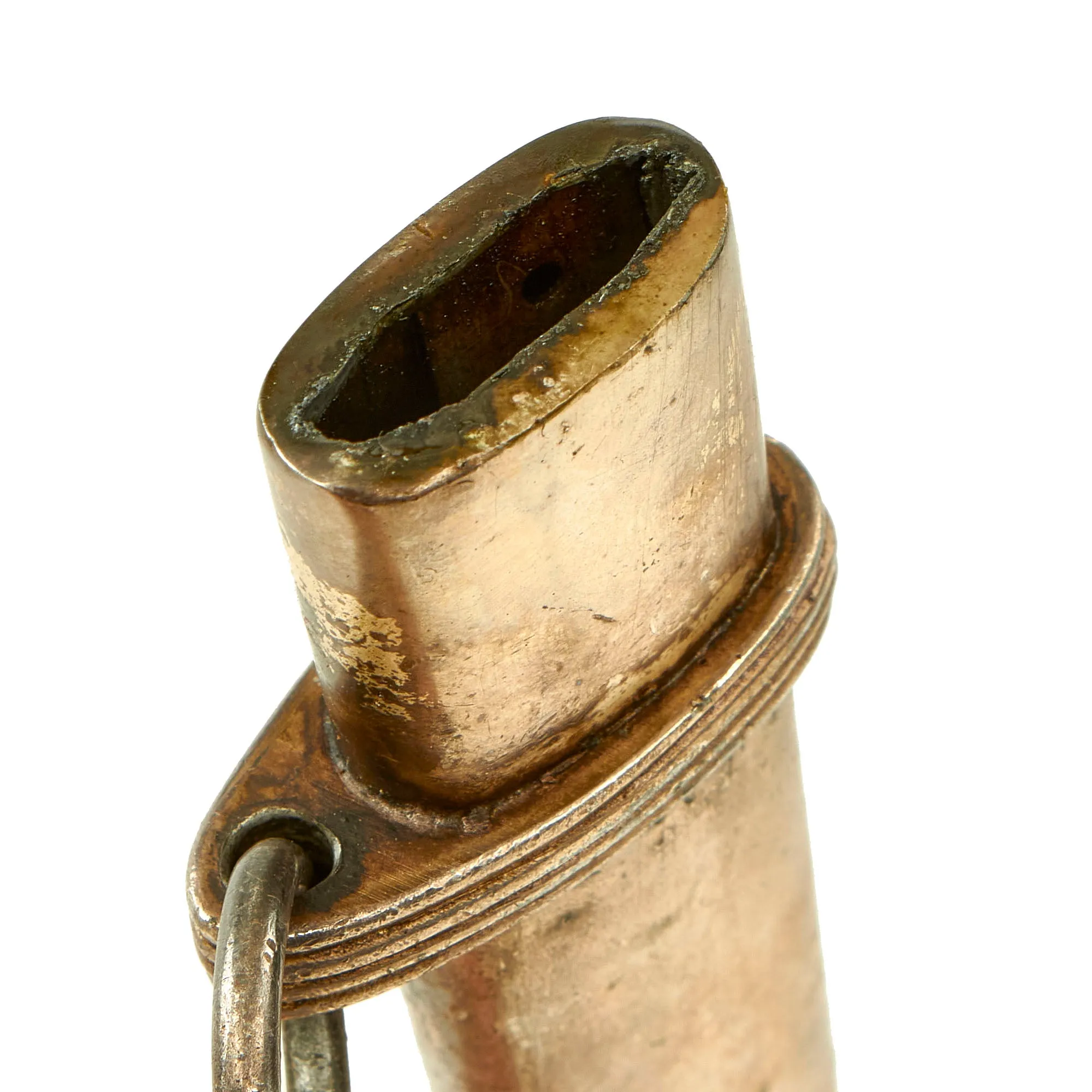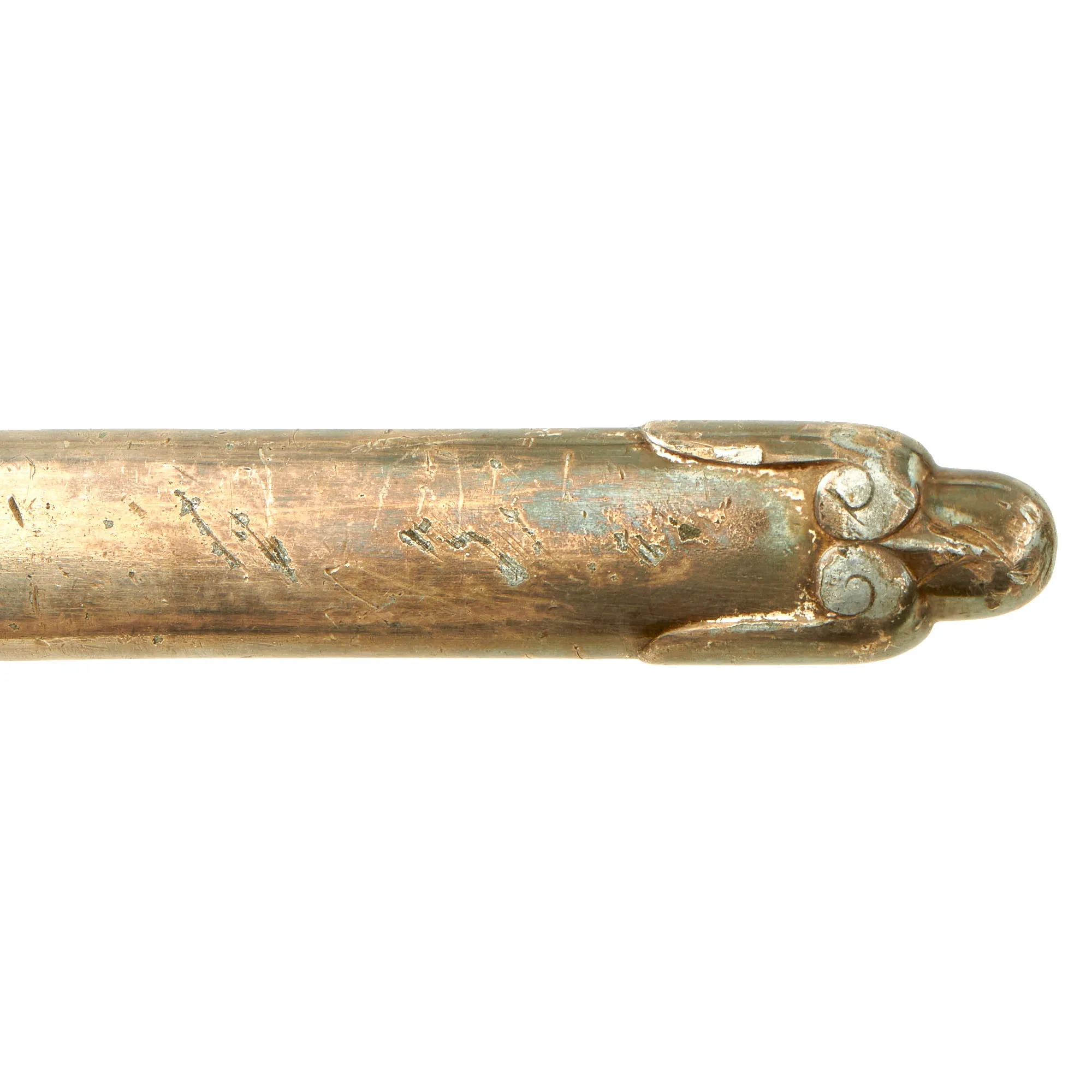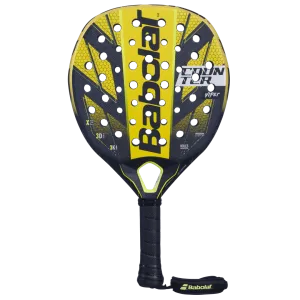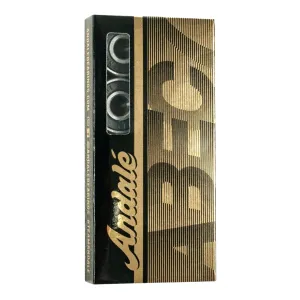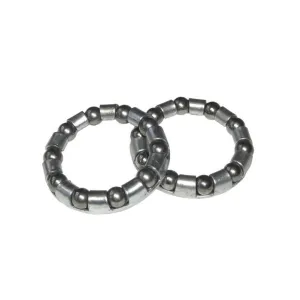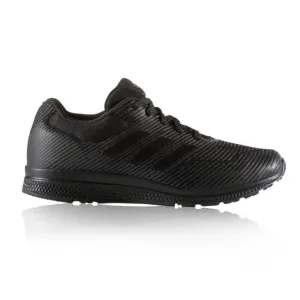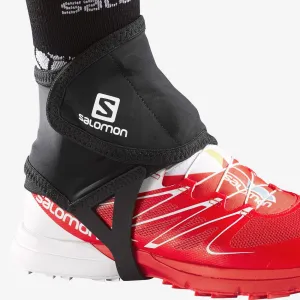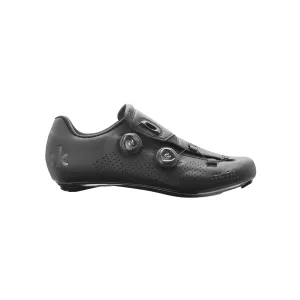Original Item: Only One Available. This is a very rare Bahnschutz Railway Protection Service 2nd Model Enlisted Man's Dagger, produced by the legendary Solingen-based firm Carl Eickhorn. The 1st Model design of this dagger was essentially the same as the Heer (Army) model dagger, but with a black celluloid grip. The 2nd model retains the black grip, though it is a bit thicker than the army version, and the rest of the fittings were changed to match the style and iconography used by the DRB. This early example features silver plated aluminum fittings, while later examples were just bright aluminum.
The two piece pommel of this dagger is in very good condition, showing much of the original silver plating, which is now tarnished to a lovely aged patina. The design features a "globe" with a train wheel around the circumference, and a "sunwheel" swas on the bottom, an allusion to how the rails of the DRB would eventually encircle the globe. This is attached to a nice ferrule on the end of the grip.
The silver plated aluminum crossguard bears the DRB "Winged Wheel" insignia in an art deco style on the front, with some lovely designs on the finials of the guard. The plating has worn away somewhat on the insignia and on the usual wear points, with the retained plating showing some lovely patination. The grip ferrule looks to be silver plated zinc, and the plating is partly retained, with the balance having flaked away, as often happens with zinc exposed to moisture.
The grip itself is lovely black celluloid, possibly over a wood base, and is in very good worn condition. There is some wear to the top of the spiral design overall, showing that it definitely saw significant use while in service. There are however no chips or cracks that we can see, and the color is just lovely.
The blade on this example is in very good condition, showing areas of staining and oxidation that look to be from water exposure. This has been cleaned away, giving the blade a mottle appearance in some areas, however in spite of this cleaning the original factory final grind cross grain is still visible throughout much of the blade. This texture is iconic, and is the definitive identifying characteristic for a real WWII German Blade. The needle-like tip is still intact, with no bending, and the edge is still nice, with no chips or sharpening, though it is a bit rough from oxidation.
The rear of the blade is etched with the 1935-41 Eickhorn trademark: a seated squirrel holding a sword, with the word ORIGINAL above and the firm's name and location, Eickhorn / SOLINGEN below. Carl Eickhorn is a legendary maker from Solingen, the famous "City of Blades" in Western Germany. According to J. Anthony Carter's book, GERMAN KNIFE AND SWORD MAKERS, this company was founded in 1865 by Carl Eickhorn, and is arguably the most famous of all Solingen makers. Not only could the family trace their history back 500 years, but they could also demonstrate involvement in the hardening and grinding industries for the same period. Truly the nobility of Solingen Edged weapon dynasties. Eickhorn edged weapons are the most desirable of all makers. The original leather blade buffer is unfortunately missing.
The scabbard is a very nice example, and looks to be silver plated aluminum with a steel runner inside, so it is slightly magnetic. It features art deco style curlicue devices on the drab, and the scabbard body is otherwise unadorned, with just the hanger rings present. This gives it a very streamlined appearance. The scabbard body does show a significant dent between the hanger rings, and has a slight bend overall, though neither of these interfere with sheathing the scabbard. The original plating is worn away in places, showing oxidation of the aluminum.
A very nice example of a rare WWII German dagger by the most famous of all Solingen makers, complete with scabbard and ready to display!
Specifications:
Blade Length: 10 1/8"
Overall length: 14 7/8"
Crossguard: 3 1/4”
Scabbard Length: 10 7/8”
The German Railway (Deutsche Reichsbahn) by the 1930's had become a very modern transportation system, serving the needs of the country, as well as a acting as throughway for other parts of Europe. It was nationalized by AH in 1937. A special protective section known as the Bahnschütz was established using Railway employees. The organization was charged with protecting the Railway system against sabotage, espionage and larceny. The first dagger allegedly worn by this organization was an Army configuration, equipped with black grip. Whether it was actually a Railway dagger is still speculation. Original examples were usually marked with the Robt. Klaas "Kissing Cranes" logo. Later a second model that bore specific Reichsbahn insignia was introduced.
Deutsche Reichsbahn (1937 to 1945)
With the Act for the New Regulation of the Conditions of the Reichsbank and the Deutsche Reichsbahn (Gesetz zur Neuregelung der Verhältnisse der Reichsbank und der Deutschen Reichsbahn) of 10 February 1937 the Deutsche Reichsbahn Gesellschaft was placed under Reich sovereignty and was given the name Deutsche Reichsbahn.
World War II and military use
The Reichsbahn had an important logistic role in supporting the rapid movement of the troops of the Wehrmacht, for example:
In all the occupied lands the Reichsbahn endeavored to incorporate the captured railways (rolling stock and infrastructure) into their system. Even towards the end of the war the Reichsbahn continued to move military formations. For example, in the last great offensive, the Battle of the Bulge (from 16 December 1944), tank formations were transported from Hungary to the Ardennes.
The railways managed by the "Eastern Railway Division" (Generaldirektion der Ostbahn) were initially run from that part of the Polish State Railways within the so-called General Government gelegene Teil der Polnischen Staatsbahnen (PKP), but from November 1939 by the Ostbahn (Generalgouvernement).
In the campaigns against Poland, Denmark, France, Yugoslavia, Greece etc. the newly acquired standard gauge networks could be used without difficulty. By contrast, after the start of the invasion of Russia on 22 June 1941, the problem arose of transferring troops and materiel to Soviet broad gauge lines or converting them to German standard gauge. Confounding German plans, the Red Army and Soviet railways managed to withdraw or destroy the majority of its rolling stock during its retreat. As a result, German standard gauge rolling stock had to be used for an additional logistic role within Russia; this required the laying of standard gauge track. The price was high: Reichsbahn railway staff and the railway troops of the Wehrmacht had to convert a total of 16,148 kilometres of Soviet trackage to German standard gauge track between 22 June and 8 October 1941.
During the war, locomotives in the war zones were sometimes given camouflage livery. In addition, locomotives were painted with the Hoheitsadler symbol (the eagle, Germany's traditional symbol of national sovereignty) holding a swas. On goods wagons the name "Deutsche Reichsbahn" was replaced by the letters "DR". Postal coaches continued to bear the name "Deutsche Reichspost".
The logistics of the Reichsbahn were crucial to the conduct of Germany's military offensives. The preparations for the invasion of Russia saw the greatest troop deployment by rail in history.
Expansion
Characteristic of the first six and a half years of this period was the exponential growth of the Deutsche Reichsbahn, which was almost exclusively due to the takeover of other national railways. This affected both parts of foreign state railways (in Austria the entire state railway) in the countries annexed by the Deutsche Reich, as well as private railways in Germany and in other countries:
The logistics of the Reichsbahn were also an important factor during the Shoah. Jews were transported like cattle to the contingent and extermination camps by the Deutsche Reichsbahn in trains of covered goods wagons, so-called Shoah trains. These movements using cattle wagons, for example, from the goods station of the great Frankfurt Market Hall thus played a significant role in the genocide within the extermination machinery of the Shoah.
Breakup of the Reichsbahn
With the end of the Second World War in 1945 those parts of the Deutsche Reichsbahn that were outside the new German borders laid down in the Potsdam Agreement were transferred to the ownership and administration of the states in whose territory they were situated. For example, on 27 April 1945, the Austrian railways became independent again as the Austrian State Railway (Österreichische Staatseisenbahn or ÖStB), later renamed as the Austrian Federal Railways (Österreichische Bundesbahnen or ÖBB) on 5 August 1947.

 Cart(
Cart(